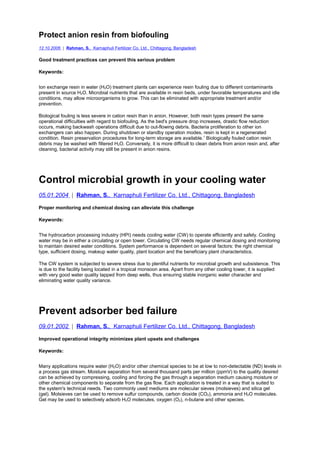Recommended
Recommended
More Related Content
What's hot
What's hot (20)
MBR Technology Suppliers and Manufacturing Company

MBR Technology Suppliers and Manufacturing Company
Membrane Bioreactor (MBR) Technology for Decentralized Wastewater Systems

Membrane Bioreactor (MBR) Technology for Decentralized Wastewater Systems
BIOTECHNOLOGICAL APPROACHES TOWARDS WATER WASTE MANAGEMENT 

BIOTECHNOLOGICAL APPROACHES TOWARDS WATER WASTE MANAGEMENT
REMOVAL OF CHROMIUM FROM WASTEWATER USING MEMBRANE SEPARATION

REMOVAL OF CHROMIUM FROM WASTEWATER USING MEMBRANE SEPARATION
The difference between sbr, mbr and mbbr-sewage treatment plants

The difference between sbr, mbr and mbbr-sewage treatment plants
Design, Commisioning & Maintenance of Sewage Treatment Plant

Design, Commisioning & Maintenance of Sewage Treatment Plant
Role of protozoa and algae in waste water treatment plant

Role of protozoa and algae in waste water treatment plant
Similar to Publications_part
Similar to Publications_part (20)
Recycling Earths Rapidly Shrinking Resources_Published

Recycling Earths Rapidly Shrinking Resources_Published
Anaerobic methods of waste water treatment v.n.nag

Anaerobic methods of waste water treatment v.n.nag
Review of research on bio reactors used in wastewater ijsit 2.4.6

Review of research on bio reactors used in wastewater ijsit 2.4.6
Treatment of High Strength Industrial Effluents Using Levapor Bio Carriers fo...

Treatment of High Strength Industrial Effluents Using Levapor Bio Carriers fo...
Wastewater Treatment Process by Physico Chemical Methods

Wastewater Treatment Process by Physico Chemical Methods
Publications_part
- 1. Protect anion resin from biofouling 12.10.2006 | Rahman, S., Karnaphuli Fertilizer Co. Ltd., Chittagong, Bangladesh Good treatment practices can prevent this serious problem Keywords: Ion exchange resin in water (H2O) treatment plants can experience resin fouling due to different contaminants present in source H2O. Microbial nutrients that are available in resin beds, under favorable temperatures and idle conditions, may allow microorganisms to grow. This can be eliminated with appropriate treatment and/or prevention. Biological fouling is less severe in cation resin than in anion. However, both resin types present the same operational difficulties with regard to biofouling. As the bed's pressure drop increases, drastic flow reduction occurs, making backwash operations difficult due to out-flowing debris. Bacteria proliferation to other ion exchangers can also happen. During shutdown or standby operation modes, resin is kept in a regenerated condition. Resin preservation procedures for long-term storage are available.1 Biologically fouled cation resin debris may be washed with filtered H2O. Conversely, it is more difficult to clean debris from anion resin and, after cleaning, bacterial activity may still be present in anion resins. Control microbial growth in your cooling water 05.01.2004 | Rahman, S., Karnaphuli Fertilizer Co. Ltd., Chittagong, Bangladesh Proper monitoring and chemical dosing can alleviate this challenge Keywords: The hydrocarbon processing industry (HPI) needs cooling water (CW) to operate efficiently and safely. Cooling water may be in either a circulating or open tower. Circulating CW needs regular chemical dosing and monitoring to maintain desired water conditions. System performance is dependent on several factors: the right chemical type, sufficient dosing, makeup water quality, plant location and the beneficiary plant characteristics. The CW system is subjected to severe stress due to plentiful nutrients for microbial growth and subsistence. This is due to the facility being located in a tropical monsoon area. Apart from any other cooling tower, it is supplied with very good water quality tapped from deep wells, thus ensuring stable inorganic water character and eliminating water quality variance. Prevent adsorber bed failure 09.01.2002 | Rahman, S., Karnaphuli Fertilizer Co. Ltd., Chittagong, Bangladesh Improved operational integrity minimizes plant upsets and challenges Keywords: Many applications require water (H2O) and/or other chemical species to be at low to non-detectable (ND) levels in a process gas stream. Moisture separation from several thousand parts per million (ppmV) to the quality desired can be achieved by compressing, cooling and forcing the gas through a separation medium causing moisture or other chemical components to separate from the gas flow. Each application is treated in a way that is suited to the system's technical needs. Two commonly used mediums are molecular sieves (molsieves) and silica gel (gel). Molsieves can be used to remove sulfur compounds, carbon dioxide (CO2), ammonia and H2O molecules. Gel may be used to selectively adsorb H2O molecules, oxygen (O2), n-butane and other species.
